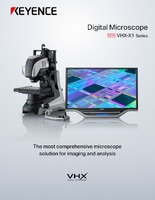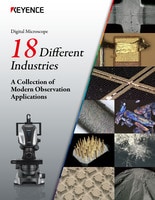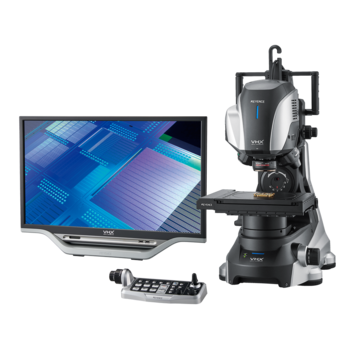Digital Microscopes
Main Types of Microscopes

The table below describes the main types of microscopes within the optical, electron, and scanning probe categories.
We’re here to provide you with more details.
Reach out today!

Optical microscope
| Type | Description |
|---|---|
| Digital microscope | A microscopes that use a camera and magnified optics. It enables to output a live image to a monitor. |
| Binocular stereoscopic microscope | A microscope that allows easy observation of 3D objects at low magnification. |
| Brightfield microscope | A typical microscope that uses transmitted light to observe targets at high magnification. |
| Polarizing microscope | A microscope that uses different light transmission characteristics of materials, such as crystalline structures, to produce an image. |
| Phase contrast microscope | A microscope that visualizes minute surface irregularities by using light interference. It is commonly used to observe living cells without staining them.What is a phase contrast microscope?With a conventional biological microscope, it is difficult to observe colorless, transparent cells while they are alive. A phase contrast microscope makes it possible by utilizing two characteristics of light, diffraction and interference, to visualize specimens based on brightness differences (contrast). Principle With regard to periodic movements, such as sinusoidal waves, the phase represents the portion of the wave that has elapsed relative to the origin. Light is also an oscillation and the phase changes, when passing through an object, between the light that has passed through (diffracted light) and the remaining light (direct light). Even if the object is colorless and transparent, there is still a change in phase when light pass through it. This phase contrast is converted into brightness differences to observe specimens. Features
Structure Because diffracted light is too weak to be normally observed by the eye, a phase plate is located at the focal point of light between the objective lens and the image surface so that only the phase of the direct light changes. This generates contrast on the image surface. |
| Differential interference contrast microscope | This microscope, similar to the phase contrast, is used to observe minute surface irregularities but at a higher resolution. However, the use of polarized light limits the variety of observable specimen containers. |
| Fluorescence microscope | A biological microscope that observes fluorescence emitted by samples by using special light sources such as mercury lamps. When combined with additional equipment, brightfield microscopes can also perform fluorescence imaging. |
| Total internal reflection fluorescence microscope | A fluorescence microscope that uses an evanescent wave to only illuminate near the surface of a specimen. The region that is viewed is generally very thin compared to conventional microscopes. Observation is possible in molecular units due to reduced background light. |
| Laser microscope (Laser scanning confocal microscope) |
This microscope uses laser beams for clear observation of thick samples with different focal distances. |
| Multiphoton excitation microscope | The use of multiple excitation lasers reduces damage to cells and allows high-resolution observation of deep areas. This type of microscope is used to observe nerve cells and blood flow in the brain. |
| Structured illumination microscope | A high-resolution microscope with advanced technology to overcome limited resolution found in optical microscopes that is caused by the diffraction of light.What is a structured illumination microscope?A type of high-resolution microscope based on technology that has overcome the limited resolution of optical microscopes caused by the diffraction limit of light. Principle Conventionally, the resolution of optical microscopes was limited to 200 nm or larger due to the diffraction limit of light. This limit has been overcome by a high-resolution microscope developed in the United States that is based on structured illumination. Structured illumination microscopy enables high-resolution images to be obtained by using the moire effect of a grid or other patterned illumination (structured illumination) to capture diffracted light, which is impossible with conventional optical microscopes. Features
Structure Structured illumination microscopes do not have a new structure but use a new way to capture light. More specifically, this type of microscope is based on moire fringes, which are caused by interference of light, and is designed to emit a specific pattern of light (structured illumination) to generate moire effects. Because images captured through this technology contain detailed information about the object, high-resolution images can be composed through computerized analysis of multiple images. |
We’re here to provide you with more details.
Reach out today!

Electron microscope
| Type | Description |
|---|---|
| Transmission electron microscope (TEM), scanning electron microscope (SEM), etc. | These microscopes emit electron beams, not light beams, toward targets to magnify them. |
We’re here to provide you with more details.
Reach out today!

Scanning probe microscope (SPM)
| Type | Description |
|---|---|
| Atomic force microscope (AFM), scanning near-field optical microscope (SNOM), etc. | This microscope scans the surface of samples with a probe and this interaction is used to measure fine surface shapes or properties. |
We’re here to provide you with more details.
Reach out today!

Others
| Type | Description |
|---|---|
| X-ray microscope, ultrasonic microscope, etc. | - |
In addition to the above categories, optical microscopes can be classified as follows:
We’re here to provide you with more details.
Reach out today!

Classification by application
| Biological microscope | With a magnification ranging from 50x to 1,500x, this microscope uses sliced samples that are fixed onto slides for observation. |
| (Binocular) stereoscopic microscope | The binocular system allows 3D observation of samples, such as insects or minerals, in their natural state without the need to be sliced. The magnification ranges from 10x to 50x. |
We’re here to provide you with more details.
Reach out today!

Classification by structure
| Upright microscope | Observes targets from above. This type of microscope is used to observe specimens on slides. |
| Inverted microscope | Observes targets from below. This microscope is used to observe, for example, cells soaked with culture in a dish. |
We’re here to provide you with more details.
Reach out today!

Magnified Observation and Instruments
A microscope is an optical instrument used to view small objects by enlarging them with two convex lenses. Optical microscopes, used for research, illuminate samples with visible or ultraviolet light. Depending on its structure, a biological microscope is categorized as an upright or inverted with a magnification ranging from 10x to 1500x.
Different types of microscopes are used based on the desired level of magnification. Magnifying glasses or loupes are used for quick inspection with a low magnification; binocular microscopes are used to observe from 10x to 50x, and upright/inverted microscopes are used to observe from 50x to 1500x.
Viewable objects by magnification
| Magnification | Instrument | Example |
|---|---|---|
|
|
Naked eye |
Hair (approx. 0.1 mm) |
|
|
Magnifying glass |
Plant or insect |
|
|
Stereoscopic microscope |
Water fleas and other microorganisms |
|
|
Upright/inverted microscope |
Insect's compound eye |
|
|
Upright/inverted microscope |
Paramecium |
|
|
Upright/inverted microscope |
Pollen |
|
|
Upright/inverted microscope |
Euglena |
|
|
Upright/inverted microscope |
Cell or chromosome |
|
|
Electron microscope |
Objects from 1μm to 0.1 nm such as a DNA (2 nm) |
Trivia: What is the reference for a magnification of 1x?
A magnification of 1x is based on the point where a nearby object can clearly be observed by the human eye. Because this distance is 250 mm (distance of distinct vision), the size that can be observed at this distance is specified as 1x.
We’re here to provide you with more details.
Reach out today!





